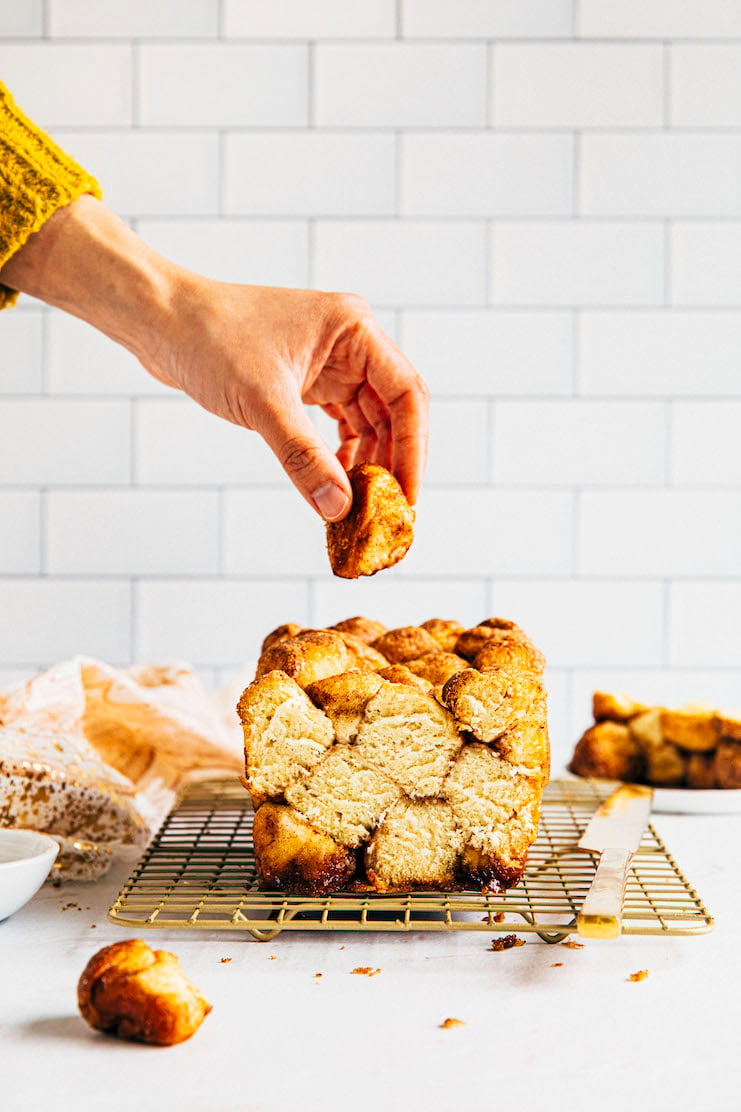
Monkey Bread Recipe In A Loaf Pan
This monkey bread recipe makes a super soft and gooey, caramel-drenched, pull apart cinnamon sugar brioche loaf! While most monkey bread recipes are typically made in a bundt pan, this recipe instructs you to make the monkey bread in a loaf pan. You get a smaller batch of monkey bread, perfect for serving 4 to 6 people! The best part? The recipe also instructs you to make the brioche dough one day ahead of the monkey bread itself. Doing so results in a more flavorful dough, and ensures that you’re not stuck in the kitchen all day making this monkey recipe!
What is monkey bread?
Hold the phone—what is monkey bread, anyway?
Monkey bread is a pastry that’s halfway between a sweet bread and a cake. Monkey bread recipes typically start with a sweet brioche dough base. The recipes then instruct bakers to assemble the dough into smaller dough balls (that resemble donut holes) and drench them in butter, cinnamon sugar, and caramel. These dough balls are then baked together in a pan to form a cake-like shape that can easily be teared or pulled apart.
Why is it called monkey bread?
Monkey bread is considered a finger food. It is typically served whole, with folks reaching into the bread to tear off little slices of themselves. As a result, some food historians argue that its name stems from people gleefully pulling apart the bread, similar to how monkeys consume their food. Other food historians argue that its unique, bubble-shaped appearance looks like an African fruit from the baobab tree called “monkey bread.” Either way, because of its distinct appearance, monkey bread is also known as “pull apart bread’ or “bubble bread”.
Where is monkey bread from?
Monkey bread was popularized in the 1980s by President Reagan’s wife, Nancy Reagan. She frequently served monkey bread at the White House during the Christmas holiday season.
However, monkey bread is actually Hungarian in origin. According to Wikipedia, Hungarian immigrants brought the very similar dessert of arany galuska when they immigrated to the United States in the 1880s.
Decades later, in 1972, Betty Crocker published a cookbook that included a recipe for arany galuska, re-branding it as “Hungarian Coffee Cake”. Eventually, the recipe title evolved to the more commonly found names of “monkey bread”, “pull apart bread”, and “bubble bread.”
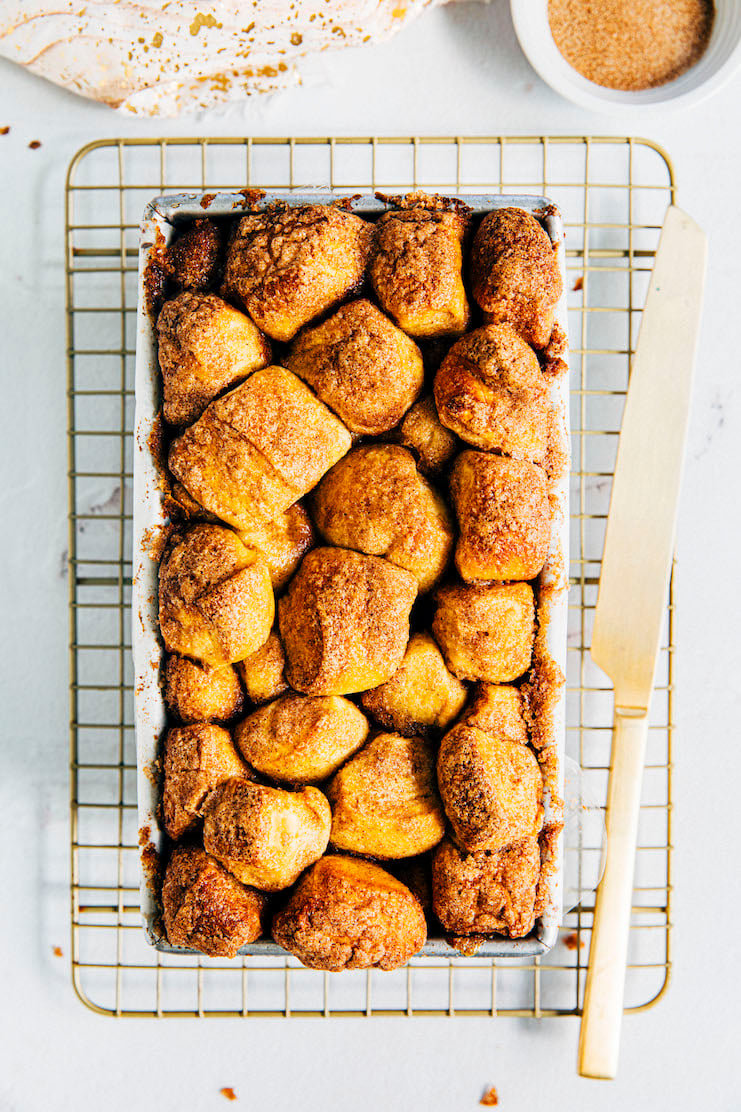
Why You Should Make This Monkey Bread Recipe
Here are all the reasons to make this monkey bread recipe in a loaf pan:
This monkey bread recipe is smaller batch.
Most monkey bread recipes instruct folks to bake the dough in a 10- or 12-inch bundt pan. Doing so yields a massive party bread that feeds 12 to 16 people. But since it’s just me and my fiancé Erlend in our household, I’m always trying to adapt my baking recipes to yield smaller batches. This monkey bread recipe is no exception! It’s about half the size of a regular monkey bread recipe, and instead just feeds 4 to 6 hungry people (or 6 to 8 more reasonable ones).
This monkey bread recipe does not need a bundt pan.
If you’ve ever wondered how to make monkey bread without a bundt pan, you’re in luck! Most monkey bread recipes make enough dough to fill a large cake pan and often instruct bakers to bake the monkey bread in a bundt pan. But not everybody has a specialized bundt pan for baking!
Enter: this monkey bread recipe. It is made in a loaf pan! Although you could argue that loaf pans are pretty specialized too, more folks have tend to have one available in their kitchens.
This monkey bread recipe is easily customizeable.
In the blog post below, I talk about all the different ways you can serve this monkey bread recipe. Its loaf pan format makes it more flexible than traditional monkey bread recipes! You can turn the monkey bread upside down and serve it whole for people to pull apart (as is the traditional way). However, I like to serve mine in slices to ensure that everybody gets their own portion. Learn more below!
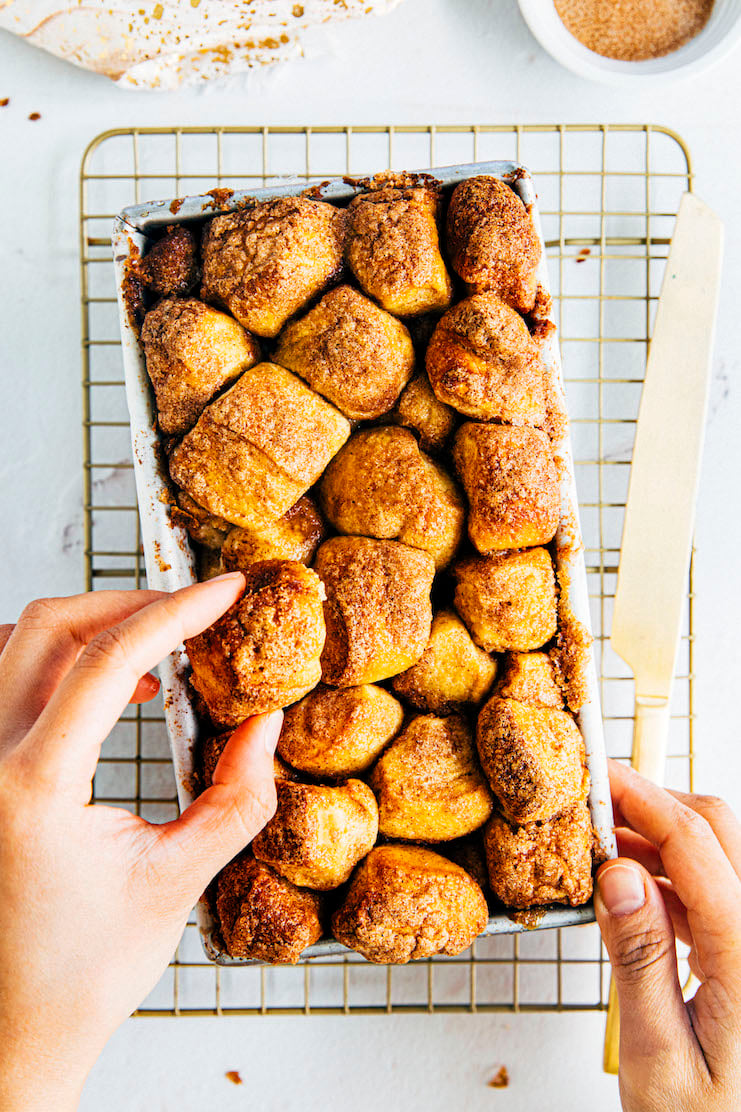
Monkey Bread Recipe Ingredients and Substitutions
Now that I’ve convinced you to make this monkey bread, here’s your shopping list for the recipe:
Shopping List for Monkey Bread Recipe In A Loaf Pan
- all-purpose flour
- granulated sugar
- instant yeast
- baking soda
- kosher salt
- buttermilk
- large eggs
- unsalted butter
- ground cinnamon
- light OR dark brown sugar
- pure vanilla extract
And let’s talk about some key ingredients and their potential substitutions:
All-Purpose Flour
You need 3 and ½ cups all-purpose flour to make the dough for this monkey bread recipe.
Can I use whole wheat flour instead of all-purpose flour in this monkey bread recipe?
Yes, with reservations. Technically, you can substitute ALL of the flour in the recipe with whole wheat flour. However, your monkey bread likely won’t be as light and fluffy as mine. I recommend substituting only half of the all-purpose flour with whole wheat flour.
Does a 1-1 gluten-free all-purpose flour work in this monkey bread recipe?
I’m sorry, but I don’t know. I rarely bake with those types of flour replacements because they’re expensive and my household is fortunate not to have any gluten restrictions. However, if you replace the flour in this monkey bread recipe with any gluten-free alternatives, please leave a comment so I can update this post accordingly!
But my gut tells me that, to make this bread gluten-free, you’re going to need to make some drastic changes to the recipe. Why? After making the dough, the recipe instructs you to knead it for a good 10 minutes. Doing so creates a ton of gluten in the dough, giving the monkey bread its signature light and fluffy texture. You likely won’t need to knead the dough for as long—or even at all!—when working with gluten-free ingredients.
Instant Yeast
You need 1 and ½ teaspoons instant yeast to make the dough for this monkey bread recipe.
Can I use active dry yeast instead of instant yeast in this monkey bread recipe?
First of all, active dry yeast and instant yeast are activated at different temperatures. In general, recipes instruct you to activate active dry yeast with ingredients that are heated to between 110° and 115°F, and instant yeast with ingredients that are heated to between 120° and 130°F.
Second, in addition to these different activation temperatures, active dry yeast and instant yeast need to be activated in different ways. Bakers activate active dry yeast by soaking it in warm water with a little bit of sugar. Instant yeast, on the other hand, can be added directly to dry ingredients (like you would baking powder or baking soda) without needing to be soaked beforehand.
So, if you’re planning on using active dry yeast in this recipe, add it directly to the warmed buttermilk with 1 Tablespoon of the sugar and let sit for 5 minutes or until foamy and emitting a distinct yeasty flavor. Then, add the mixture to the recipe at the same time as the egg and melted butter.
Kosher Salt
You need 1 teaspoon kosher salt to make the brioche dough for this monkey bread recipe, plus another ¼ teaspoon to make its caramel sauce.
Why You Should Use Kosher Salt When Baking
I like to use kosher salt (as opposed to table salt) when baking. Its larger crystals make it difficult to confuse with granulated sugar. However, not all kosher salts are created equal. Some kosher salts have smaller granules than others, which will result in saltier tasting baked goods.
For consistency, I recommend sticking to one brand, and one brand only: Diamond Crystal kosher salt. It’s the only brand of salt I use when I develop recipes for Hummingbird High. Why? Diamond Crystal kosher salt is one of the few 100% pure salts in the grocery store. Other brands have additives that can add unexpected flavors to your desserts.
I can’t find Diamond Crystal kosher salt. Is Morton’s Coarse kosher salt okay?
Yes, with reservations. Morton’s Coarse kosher salt granules are much smaller, denser, and crunchier than Diamond Crystal. According to this Food52 article, the two are different shapes and sizes because of how they’re made. Morton’s is made by flattening salt granules into large thin flakes by pressing them through high-pressure rollers, whereas Diamond Crystal is formed by a patented method in which “upside-down pyramids [are] stacked one over the next to form a crystal.” You can even see a visualization of the different sizes in this Cook’s Illustrated article.
Okay, but what does that mean, exactly? 1 teaspoon of Morton’s will taste saltier than 1 teaspoon of Diamond Crystal. Wild, right? So if you follow my recipes exactly as they are written but use Morton’s instead of Diamond Crystal, the results will come out saltier. In fact, sometimes they will come out TOO salty. So if you’re using Morton’s instead of Diamond Crystal, reduce the salt in the recipe by half.
Want to learn more about Diamond Crystal versus Morton’s Coarse kosher salt? Definitely check out the Food52 and Cook’s Illustrated articles I linked to above, as well as this Taste article.
I can’t find Diamond Crystal OR Morton’s Coarse kosher salt. Can I just use table salt?
Yes, with reservations. If you use table salt, you’ll need to reduce the recipe’s salt quantity by half.
If you read my little essay about Diamond Crystal and Morton’s, you learned that Diamond Crystal kosher salt granules are larger than Morton’s kosher salt granules. The same principle applies to table salt versus kosher salt. Table salt granules are much smaller than kosher salt granules. As a result, 1 teaspoon of table salt tastes much saltier than 1 teaspoon of kosher salt… simply because it can hold more granules! Wild, right?
So if you follow my recipes exactly as they are written but use table salt instead of kosher salt, the results will come out saltier. If you’re using table salt instead of kosher salt, I recommend reducing the salt in the recipe by half.
Buttermilk
You need 1 cup buttermilk to make the brioche dough for this monkey bread recipe.
I don’t have buttermilk. What can I use instead?
Make your own buttermilk with whole milk. Whisk together 1 cup (8 ounces or 227 grams) whole milk and 1 Tablespoon white vinegar or lemon juice in a small liquid measuring cup. Let sit for 5 minutes to thicken, then use as directed in the recipe. Although you can technically use non-fat or skim milk to make buttermilk, I don’t recommend it. These non- and low-fat versions will lead to less flavorful baked goods.
Alternatively, you can also make your own buttermilk with yogurt. I learned this neat trick from another food blogger friend of mine. She thins out 1 cup natural, unsweetened, and unflavored yogurt with ½ cup water to use in place of buttermilk. She says that you can also use a thicker yogurt (like Greek yogurt), but you’ll likely need to use more water to get it to the consistency of buttermilk. Similar to my note above, use whole yogurt if possible. Non- and low-fat yogurts will result in less flavorful baked goods.
Brown Sugar
You need ½ cup light OR dark brown sugar for the monkey bread’s cinnamon sugar coating, plus another 2 Tablespoons for its caramel sauce.
Light versus Dark Brown Sugar
Brown sugar is granulated white sugar with a touch of molasses to give it its signature color and flavor. Because brown sugar contains molasses, it adds more moisture baked goods than granulated sugar otherwise would.
Brown sugar is available in two varieties: light or dark. Dark brown sugar is my personal preference; because it contains more molasses, I find it to be more flavorful. However, you can use either in this monkey bread recipe without altering its flavor too much.
I don’t have brown sugar. Can I use granulated (white) sugar instead in this monkey bread recipe?
Yes, with reservations. You can replace the brown sugar in this recipe with the same amount of granulated sugar. However, your monkey bread will likely taste sweeter with less nuanced flavors. The molasses in brown sugar helps “chill” the sweetness of this recipe, and adds some necessary butterscotch and caramel flavors.
Can I use coconut sugar instead of brown sugar in this monkey bread recipe?
Yes! You can use coconut sugar instead of brown sugar for both the cinnamon sugar coating and the caramel sauce. I think it would be a delicious substitution!
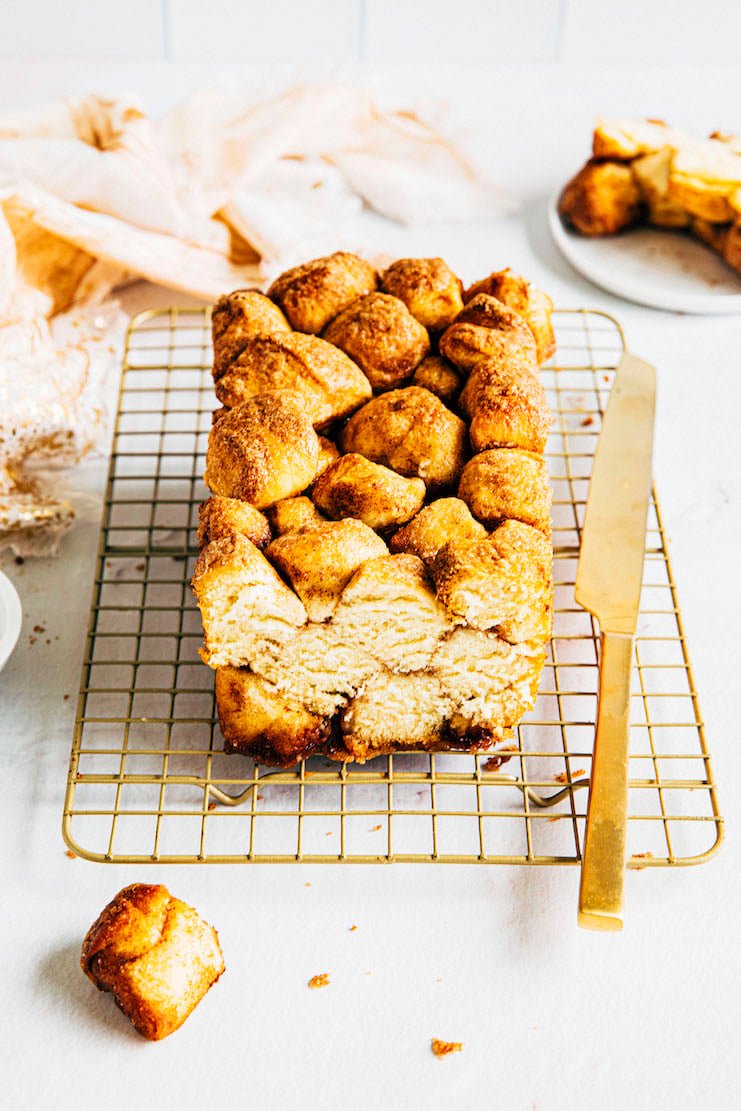
How To Make Monkey Bread In A Loaf Pan
Whenever I make an elaborate yeast-based recipe like cinnamon rolls, babka, and this monkey bread recipe, I make the dough the day ahead of assembling the baked good. Why? It can be really time-consuming to make the recipe all in one day! First, you need to make the dough, let it rise for 1 to 2 hours, then punch it down and assemble it into the baked good. Then, you let that rise again for another 1 to 2 hours before baking it. You can easily see how that recipe quickly turned into a full day in the kitchen.
To make sure I’m not stuck in the kitchen all day, I broke down the work for this monkey bread recipe over the course of two days. Here’s what I did:
Day 1: Make The Brioche Dough
- Prep the ingredients for the brioche dough. (Prep Time: 10 minutes)
For this recipe, it’s important that all its ingredients are at the temperature listed in the recipe. Why? Remember that yeast is a living thing. If you activate the yeast at a temperature that’s too warm, you might accidentally kill the yeast and end up with a dough that doesn’t rise. However, on the flip side, the yeast won’t activate if other ingredients—like the buttermilk, egg, and melted butter—are too cold. So, to really set yourself up for success, take the extra 5 minutes to make sure all the ingredients are measured out and are at the right temperatures! - Make the dough. (Work Time: 15 minutes)
After you’ve prepped the ingredients, making the dough itself is a breeze. First, mix together the dry ingredients in a stand mixer. Pour in the wet ingredients and let the stand mixer knead it into a beautiful, elastic dough for 10 minutes. That’s it! - Proof the dough. (Rise Time: Overnight)
Once the dough is ready, cover the bowl with plastic wrap and stick it in the refrigerator. The fridge’s cooler temperature enables the dough to rise at a slower pace than it otherwise would at room temperature. The next morning, you end up with a perfectly risen dough that’s perfect for shaping and baking!
Day 2: Assemble The Monkey Bread
First, prep the ingredients needed to assemble the monkey bread.
- Prep the ingredients for the cinnamon sugar coating and the caramel sauce. (Prep Time: 5 minutes)
Unlike the ingredients for the brioche dough, the ingredients for the cinnamon sugar coating and caramel sauce don’t require too much prep! Simply melt the butter for the cinnamon sugar coating and set it aside. Then, whisk together brown sugar, granulated sugar, and cinnamon in a small bowl. Set the ingredients for the caramel sauce over by your range.
Then, assemble and proof the monkey bread.
- Roll out the dough. (Work Time: 5 minutes)
Remove the dough from the refrigerator and tip it onto a lightly floured counter. Use a rolling pin to roll the dough into a rough oval about ½ inch thick. Don’t worry too much about the size and shape of the dough! You’ll be cutting the slab of dough into smaller squares anyway in the next step. What matters most is the thickness of the dough—like I said, aim for a ½ inch thick slab. - Assemble the dough. (Work Time: 15 minutes)
Use a bench scraper or pastry cutter to divide the dough into 1-inch squares. The fastest way to do so is to slice 1-inch wide strips vertically down the slab—don’t move the strips just yet! Keep them fairly close together so you can then slice 1-inch wide strips horizontally across them. Et voila! You’ve divided the dough into 1-inch squares. Don’t worry about trying to get a specific number of dough balls. What matters more is to try and get the squares as even as you can.
Once you’ve divided the dough, use your hands to roll each square into a small ball. How? It’s time to use some childhood skills here: pick up each square and roll it back and forth in quick motions between your hands like you would clay or Play-Doh. Super fun, right?! - Coat the dough. (Work Time: 5 minutes)
Place the dough balls in a large bowl. Then, drizzle the dough balls with the melted butter for the coating and gently toss until they are coated. Be careful here! Depending on how long it took you to form the dough balls, the dough might have softened and started to expand already. You don’t want to squish them too much and have them lose their round shape. Toss them gently!
Once they’re completely coated in the butter, whisk together the remaining ingredients for the coating and sprinkle them over the dough balls. Gently toss again until the balls are coated.
Finally, prep the monkey bread for baking.
- Proof the dough. (Rise Time: 1 to 2 hours)
Place the dough balls in the prepared pan. You can transfer them one by one with tongs, or just use a rubber spatula to gently tip and guide them from the bowl into the loaf pan. Make sure to transfer any leftover butter and sugar coating, too. Cover with plastic wrap and let sit in a warm spot for 1 to 2 hours, or until puffy. Don’t forget to preheat your oven! I like to preheat mine about 30 minutes into the second rise to ensure that it’s ready when the dough has finished rising. - Make the caramel sauce. (Work Time: 5 minutes)
Once the dough has finished its second rise, make the caramel sauce. Don’t worry—it comes together super quickly. All you need to do is melt the butter for the sauce in a small, heavy-bottomed sauce pan, then whisk in the sugar, salt, and vanilla. That’s it! Pour the warm caramel over the dough immediately before baking. - Bake the monkey bread. (Bake Time: 40 minutes)
The monkey bread needs 40 to 45 minutes in the oven, or until the top of the bread looks crispy with caramelized sugar and is golden brown. However, take that with a grain of salt. It can be hard to tell when bread is done just by appearance! The most accurate way to test for doneness is to insert an instant read thermometer into the center of the loaf. When done, the thermometer will read between 190°F and 200°F.
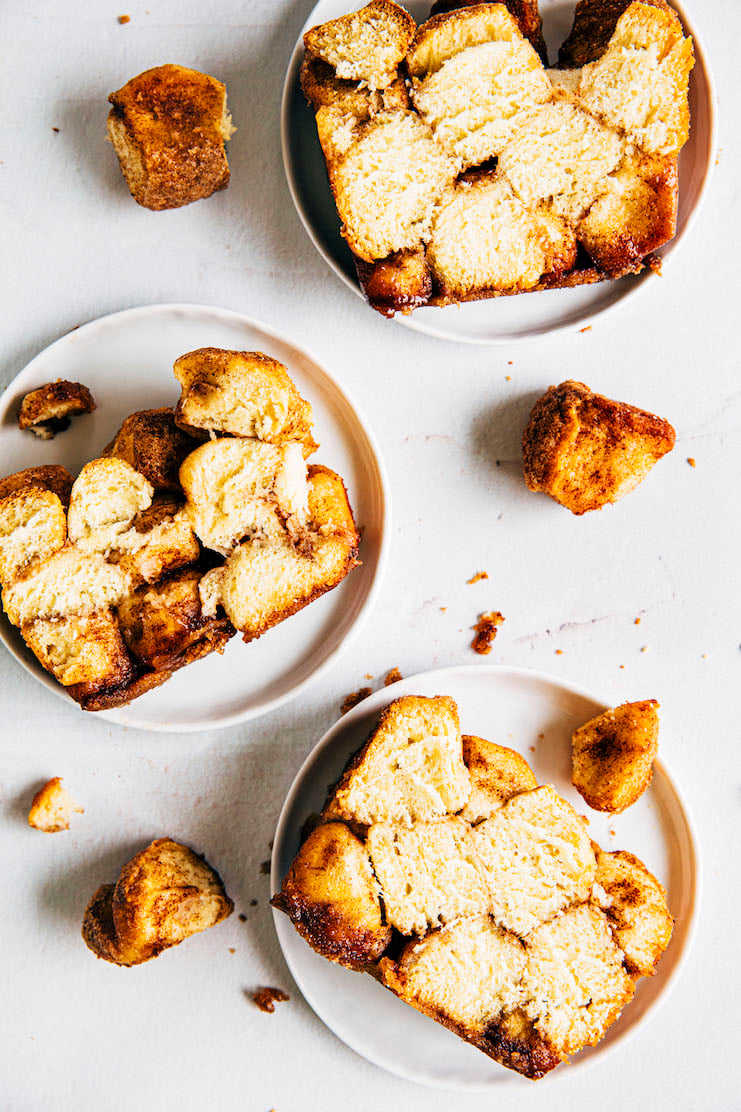
Monkey Bread Recipe Troubleshooting and FAQ
FAQ: Equipment To Make Monkey Bread In a Loaf Pan
I don’t have a stand mixer. Can I still make this monkey bread recipe?
Absolutely! Instead of using a stand mixer, knead the dough by hand until it is smooth and elastic. The recipe instructs you to knead it for 10 minutes in a stand mixer; however, you may need to do a few minutes of extra kneading when doing it by hand.
Can I use an 8 x 4-inch loaf pan to make this monkey bread recipe?
Yes! If you don’t have a 9 x 5-inch loaf pan, an 8 x 4-inch loaf pan bakes this recipe just as well. You’ll end up with a taller loaf, too! Just note that you may need to bake the monkey bread for an additional 5 minutes (since you’re cramming the same amount of dough into a smaller pan, essentially).
FAQ: Monkey Bread Recipe In A Loaf Pan Techniques
Can I make this monkey bread recipe all in one day (as opposed to proofing the dough overnight)?
Absolutely! To do so, follow the recipe instructions to make the brioche dough. However, instead of transferring it to the fridge to rise overnight, simply let it rise at room temperature for 1 to 2 hours or until doubled in size. Then, follow the recipe instructions to assemble the dough into the monkey bread and bake. That’s it!
I know you recommend making the brioche dough one day in advance of assembling the monkey bread. But how far out can I make the brioche dough?
Good question! You can refrigerate the brioche dough for up to 3 days before using it to assemble the monkey bread.
FAQ: Monkey Bread Recipe In A Loaf Pan Troubleshooting
Help! My monkey bread didn’t rise and/or don’t look as tall and puffy as yours. What did I do wrong?
Uh oh. Did you pay attention to the temperature of the ingredients listed in the recipe? I mentioned earlier that, for this recipe, it’s super important to prep your ingredients to the temperature listed in the recipe. If the buttermilk is warmed too much, it will kill the yeast. At worst, your dough won’t rise at all. At best, your monkey bread crumb won’t be as tall and fluffy as mine.
Similarly, if the buttermilk, eggs, and butter are too cold, it won’t activate the yeast. In this case, your brioche dough won’t rise and/or your monkey bread won’t be as tall and fluffy as mine, either.
FAQ: Serving and Storing This Monkey Bread Recipe
How To Serve This Monkey Bread Recipe
It’s important to serve monkey bread warm, preferably straight from the oven.. Doing so makes it easy to pull apart since it’s still soft and gooey from the oven. Additionally, this monkey bread recipe can be served in several ways:
- Pull-Apart Style or Slices
Traditionally, monkey bread is served whole. Folks then reach into the bread, pulling and tearing apart the individual gooey dough balls as a way of serving themselves. However, since there’s a worldwide pandemic going on, I thought it might be best to rethink that serving style (lollll #sorrynotsorry). Since this monkey bread is made in a loaf pan, you can slice it into individual portions, similar to how you would slice banana bread or a whole loaf of bread into toast. That way, each person can still get the fun pull apart experience without contaminating the whole thing. - Caramel Top or Bottom
Typically, when monkey bread is baked, most of the caramel sauce pools at the bottom of the pan. The maker then inverts the bread out of its pan onto a serving plate, ensuring that the caramel sauce then ends up on top of the bread. If you’re serving this monkey bread whole, I recommend inverting it out of the loaf pan and onto a new serving plate to ensure that the caramel soaked portions ends up on top.
That being said, you can also leave the monkey bread in its pan and serve it as is with the caramel on the bottom. It’s just as good—I promise!
How To Store This Monkey Bread Recipe
The monkey bread can be stored at room temperature, tightly wrapped in plastic wrap, for up to 3 days. Rewarm in the microwave or oven before serving.
Can you freeze this monkey bread recipe?
Yes! You can freeze the monkey bread after it’s been baked. Tightly wrap any leftover monkey bread slices in plastic wrap. Freeze for up to 3 months. To serve, thaw overnight in the refrigerator and rewarm in the oven or microwave.
Best Monkey Bread Recipe Tips and Techniques
Best Ingredient Tips
- Just another friendly reminder to make sure to pay attention to the ingredients and the temperatures they’re listed at in the recipe. Yeast is a living thing and you can easily kill it by mixing it in a liquid that’s too hot. You want the temperature to be similar to that of a warm bath and no more. Be sure to use an egg that’s at room temperature rather than straight from the fridge. An egg straight from the fridge will be too cold and lower the temperature of the overall mixture, potentially dropping it to a point where the yeast won’t activate properly.
- The monkey bread recipe instructs you to use butter that’s melted and cooled slightly for both the brioche dough and cinnamon sugar coating. What does that mean? Dip your finger in the butter—it should feel warm, but not overly hot that you feel like you’ve burned yourself. Aim for a temperature similar to a warm, pleasant bath. To get to this temperature, I like to melt my butter first to allow it to cool slightly while I prep the rest of the ingredients.
Best Technique Tip
- Dough rises fastest and best on warm, humid days. Although you can get the same effect on cold, dry days, it can take two to three times as long to proof dough. This is why professional bakeries have dedicated drawers to proof dough. The proofing drawer mimics the environmental conditions of a warm, humid day. And guess what? You can do that at home with the oven you already have. First, if your oven has an interior light, turn it on—doing so increases the temperature inside the oven by about five degrees. Next, bring 2 to 4 cups of water to a boil and pour it into a heatproof glass or ceramic bowl. Place the bowl of water in the oven, then place the dough you’re trying to proof next to it. The warmth from the light and moisture from the steaming, hot water will create a warm, humid environment in the oven to proof the dough faster.
- To make the monkey bread, the recipe instructs you to roll out the brioche dough and cut it into 1-inch squares. Don’t worry too much about rolling the brioche dough into a precise shape—all you need is a lab that is about ½ inch thick. From there, you’ll cut the dough into 1-inch squares and roll each one into a ball. Again, don’t worry about being too precise about the shape of the squares since you’ll roll each one into a ball, anyway! After that, you’ll toss the dough balls in melted butter and the cinnamon sugar coating. Be careful not to squish them too hard as you do so; otherwise the dough balls will lose their shape!
- It can be hard to tell when shaped sweet breads are done just by apperance alone. So the most accurate way to test for doneness is to insert an instant read thermometer into the center of the loaf. When done, the thermometer will read between 190°F and 200°F.
Best Tip To Fit This Recipe Into Your Schedule
- Don’t want to wait overnight for your monkey bread recipe? Don’t worry—you can make this recipe all in one day! To do so, follow the recipe instructions to make the brioche dough. However, instead of transferring it to the fridge to rise overnight, simply let it rise at room temperature for 1 to 2 hours or until doubled in size. Then, follow the recipe instructions to assemble the dough into the monkey bread and bake.
More Pull-Apart Bread Recipes
More Bready Dessert Recipes
More Bread Pastries
- Caramel Apple Butter Sticky Buns
- Chocolate Babka Morning Buns
- Filipino Ensaymada
- Small Batch Cinnamon Rolls
- Small Batch Pecan Sticky Buns
Get the Recipe: Monkey Bread In A Loaf Pan Recipe
Ingredients
For the Brioche Dough
- 3 ½ cups (15.75 ounces or 447 grams) all-purpose flour, plus more for dusting
- 3 Tablespoons granulated sugar
- 1 ½ teaspoons instant yeast
- ½ teaspoon baking soda
- 1 teaspoon kosher salt
- 1 cup (8 ounces or 227 grams) buttermilk, warmed to between 120°F and 130°F
- 1 large egg, at room temperature
- 4 Tablespoons (2 ounces or 57 grams) unsalted butter, melted and cooled slightly
For the Cinnamon Sugar Coating
- ½ cup (4 ounces or 113 grams) unsalted butter, melted and cooled slightly
- ½ cup tightly packed (3.75 ounces or 106 grams) light OR dark brown sugar
- ½ cup (3.5 ounces or 99 grams) granulated sugar
- 4 teaspoons ground cinnamon
For the Caramel Sauce
- 4 Tablespoons (2 ounces or 57 grams) unsalted butter
- 2 Tablespoons light OR dark brown sugar
- ¼ teaspoon kosher salt
- 1 teaspoon pure vanilla extract
Equipment
- a stand mixer with a dough hook
- a liquid measuring cup
- a 9 x 5-inch OR 8 x 4-inch loaf pan
- a rolling pin
- a bench scraper OR pastry cutter
- an instant read thermometer
Instructions
Day 1: Make the Brioche Dough
- Mix the dry ingredients. In the bowl of a stand mixer fitted with a dough hook, combine the flour, sugar, yeast, baking soda, and salt. Knead on low to combine, about 30 seconds. Press a tall measuring cup in the center of the ingredients to make a well.
- Mix the wet ingredients, then combine them with the dry ingredients. In a large liquid measuring cup, whisk together the buttermilk, egg, and butter. Pour the mixture into the well in the dry ingredients. Use a rubber spatula to briefly mix the wet ingredients into the dry ingredients, until a shaggy dough forms.
- Knead the dough. Knead on medium-low for 10 minutes, or until smooth and elastic, using the spatula to scrape down the bottom and sides of the bowl as necessary.
- Prep the dough for proofing. Tip the dough out onto a lightly floured counter. Dust your hands with flour and knead the dough once or twice into a rough ball. Scrape down the bottom and sides of the bowl to remove any excess dough. Spray the bowl with cooking spray and place the dough back in the bowl. Cover with plastic wrap and refrigerate overnight.
Day 2: Assemble the Monkey Bread
- Prep the loaf pan. Spray a 9 x 5-inch loaf pan with cooking spray and line it with parchment paper, leaving a 2-inch overhang on the long sides. Spray the parchment, too.
- Roll out the dough. Remove the dough from the refrigerator, uncover it, and discard the plastic wrap. Tip it onto a lightly floured counter and use a rolling pin to roll the dough into a rough oval about ½ inch thick.
- Make the dough balls. Use a bench scraper or pastry cutter to divide the dough into 1-inch squares. Working quickly, use your hands to roll each square as you would clay or Play-Doh, rolling it back and forth in quick motions until it forms a small ball. Place the balls in a large bowl as you go.
- Coat the dough balls. Drizzle the dough balls with the melted butter for the coating and gently toss until the dough balls are completely coated. Whisk together the brown sugar, granulated sugar, and cinnamon for the coating in a small bowl. Sprinkle the mixture over the dough balls and toss until the dough balls are completely coated.
- Prep the dough for proofing. Place the dough balls in the prepared pan. Cover with plastic wrap and let sit in a warm spot for 1 to 2 hours, or until puffy.
- Preheat the oven and the sheet pan. About 30 minutes into the second rise, position a rack in the center of the oven and preheat the oven to 350°F. Line a quarter or half sheet pan with parchment paper.
- Make the caramel sauce. When the dough is ready for baking, make the caramel sauce. Melt the butter for the caramel sauce in a small, heavy-bottomed saucepan. Remove from the heat, immediately add the sugar, salt, and vanilla, and whisk until smooth.
- Finish assembling the monkey bread for baking. Place the loaf pan with the dough on top of the prepared sheet pan. Pour the warm caramel over the dough, coating the top of the dough completely.
- Bake the monkey bread. Bake the monkey bread for 40 to 45 minutes, or until the top of the loaf is golden brown. An instant read thermometer inserted into the center of the loaf should read between 190°F and 200°F.
- Serve and store. Serve immediately, or warmed. The monkey bread can be stored at room temperature, tightly wrapped in plastic wrap, for up to 3 days.
Notes
- Just another friendly reminder to make sure to pay attention to the ingredients and the temperatures they’re listed at in the recipe. Yeast is a living thing and you can easily kill it by mixing it in a liquid that’s too hot. You want the temperature to be similar to that of a warm bath and no more. Be sure to use an egg that’s at room temperature rather than straight from the fridge. An egg straight from the fridge will be too cold and lower the temperature of the overall mixture, potentially dropping it to a point where the yeast won’t activate properly.
- The monkey bread recipe instructs you to use butter that’s melted and cooled slightly for both the brioche dough and cinnamon sugar coating. What does that mean? Dip your finger in the butter—it should feel warm, but not overly hot that you feel like you’ve burned yourself. Aim for a temperature similar to a warm, pleasant bath. To get to this temperature, I like to melt my butter first to allow it to cool slightly while I prep the rest of the ingredients.
- Dough rises fastest and best on warm, humid days. Although you can get the same effect on cold, dry days, it can take two to three times as long to proof dough. This is why professional bakeries have dedicated drawers to proof dough. The proofing drawer mimics the environmental conditions of a warm, humid day. And guess what? You can do that at home with the oven you already have. First, if your oven has an interior light, turn it on—doing so increases the temperature inside the oven by about five degrees. Next, bring 2 to 4 cups of water to a boil and pour it into a heatproof glass or ceramic bowl. Place the bowl of water in the oven, then place the dough you’re trying to proof next to it. The warmth from the light and moisture from the steaming, hot water will create a warm, humid environment in the oven to proof the dough faster.
- To make the monkey bread, the recipe instructs you to roll out the brioche dough and cut it into 1-inch squares. Don’t worry too much about rolling the brioche dough into a precise shape—all you need is a lab that is about ½ inch thick. From there, you’ll cut the dough into 1-inch squares and roll each one into a ball. Again, don’t worry about being too precise about the shape of the squares since you’ll roll each one into a ball, anyway! After that, you’ll toss the dough balls in melted butter and the cinnamon sugar coating. Be careful not to squish them too hard as you do so; otherwise the dough balls will lose their shape!
- It can be hard to tell when shaped sweet breads are done just by apperance alone. So the most accurate way to test for doneness is to insert an instant read thermometer into the center of the loaf. When done, the thermometer will read between 190°F and 200°F.
- Don’t want to wait overnight for your monkey bread recipe? Don’t worry—you can make this recipe all in one day! To do so, follow the recipe instructions to make the brioche dough. However, instead of transferring it to the fridge to rise overnight, simply let it rise at room temperature for 1 to 2 hours or until doubled in size. Then, follow the recipe instructions to assemble the dough into the monkey bread and bake.
get new recipes via email:
Did you make this recipe?
Please leave a comment and rating for the recipe using the form below!
Your ratings make it easier to find the recipe online, and I’m always looking for ways to improve Hummingbird High.

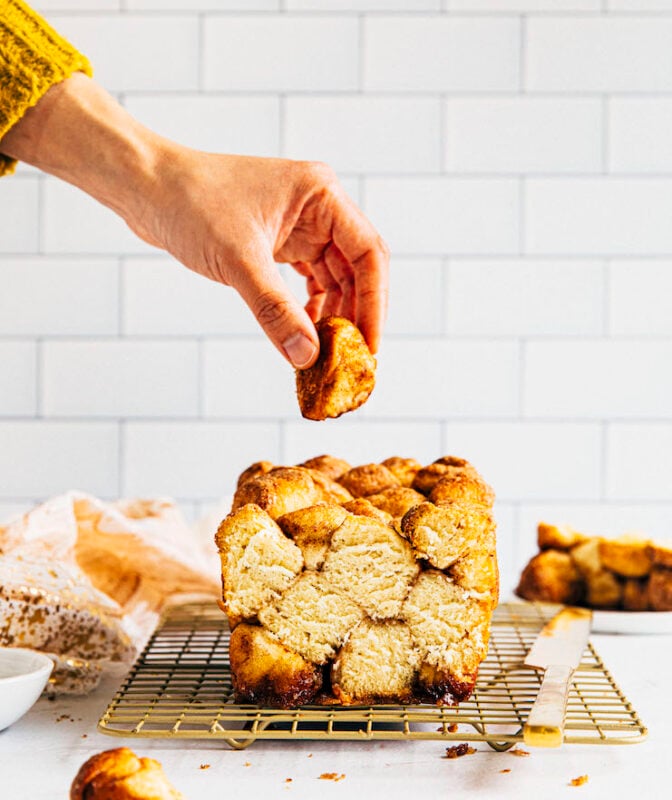
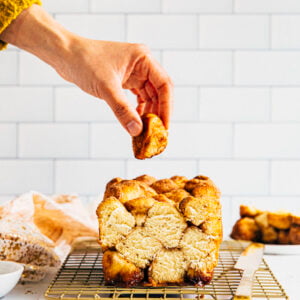
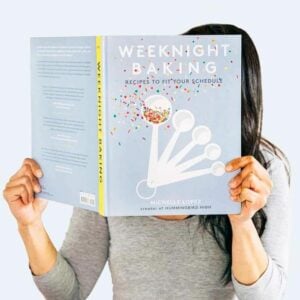

Such a fun recipe! I hadn’t made any kind of monkey bread before (it always seems like a lot of work), and the tips and hints walked me through the recipe without any trouble at all.
The step that took the longest was slicing the dough and rolling it up into little balls – so I would honestly rank this whole recipe as pretty easy. And, if you bake a lot, you more than likely already have all of the recipe ingredients around the kitchen.
Definitely going to be bringing this one out again for treats this Fall.